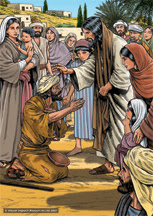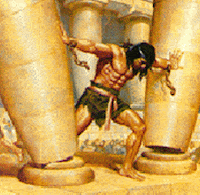
The latest set of Bible pictures to be added to the 'Bible Picture website' tells the story of the healing of
blind Bartimaeus. The story takes place on the outskirts of Jericho.
Jericho had the ancient title of 'City of Palm trees' referring to the abundance of palm trees in the area, so remember to add palm trees when illustrating one of the many stories that take place here. Jericho is believed to be the second oldest continuously inhabited city in the world, and has been described as a "lush green oasis in the desert". The fertile soil of Jericho, which once made it famous for its groves of balsam, spice and date palms, was apparently due to the skillful irrigation of earlier times. For this reason Josephus refers to it as the "divine district".
Just like today, those who beg chose the busiest thoroughfares to position themselves in. Many Jews met in Jericho before traveling to Jerusalem for the passover celebrations, so the road leaving Jericho became a popular spot for beggars. Bible artist William Hole, who visited the Holy land to gather references for his Bible pictures, noticed that blind beggars had their begging bowls fastened to their waist by a cord. Presumably to deter potential thieves. It's reasonable to assume that this practice was passed down from ancient times.
In his book
'The Life of Jesus of Nazareth' Hole points out that blindness in Palestine during this period was
"grievously common, the proportion of those afflicted being one in every hundred of the population".In picture 3, Bartimaeus has discarded his blanket, (Mark 10: 50), and is kneeling at the feet of Jesus. The act of discarding his cloak is very significant as it was his only possession. (He had forsaken all to follow Jesus!) This cloak would have been his only protection from the cold at night, and his only shade from the hot sun during the day. So important was a poor man's cloak that the Bible, (in Exodus 22: 26-27), sets down strict regulations regarding its use as property. It states that even if this garment has been pawned, it must be returned to its owner before sun down, for
"What else will he sleep in". I've heard, although I've not checked it out, that begging in Bible times was a recognized profession for those who were unable to support themselves, (e.g. those who were blind and lame etc), and that beggars wore a cloak that identified them as beggars, a kind of official uniform! This made the discarding of this beggars uniform an act of faith on the part of Bartimaeus, trusting that he would no longer need it. I'm not sure if Josephus mentions anything about this. I would be interested to know if there is any evidence to suggest what color a beggars cloak might have been.
In picture 4 we see Jesus walking away in the distance. the Bible says that Bartimaeus followed Him in the way. Notice that the road that Jesus took was the road to Jerusalem, and the cross! Bartimaeus was one of the few followers of Jesus who was ready to follow Him all the way to the cross.
There are four pictures in this set which gives us a new total picture count of 695!
The next picture set I will be working on is a new version of the Nativity, which (God willing), should be ready in a couple of weeks or so. We do already have Bible picture sets of the Nativity for those who can't wait, but the new ones will be in the new (more detailed) style.
Posts on other Bible stories
The Rich Young RularZacchaeusCrucifixion part 1Crucifixion part 2On the road to EmmausThe NativityRaising LazarusWoman taken in Adultery




